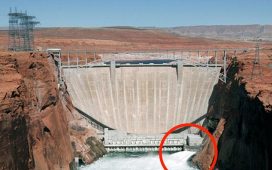A group of researchers working in Montana‘s Hell Creek Formation have discovered the fossilized remains of four different dinosaurs, including one that may be a new species.
The paleontologists, which come from the University of Washington and the Burke Museum, discovered the ilium (or hip bone) of an ‘ostrich-sized theropod,’ a group that includes carnivorous two-legged dinosaurs such as the T. rex or raptor and the hips and legs of a duck-billed dinosaur.
They also unearthed a pelvis, toe claw and limbs from another theropod that could be the rare Anzu (also known as the ‘chicken from hell’) or perhaps a new species; as well as the skull and other bones from a Triceratops.

Researchers found the skull and other bones from a Triceratops. The ‘trailer hitch’ or occipital condyle bone (pictured), connects the skull to the neck vertebrae
‘Each fossil that we collect helps us sharpen our views of the last dinosaur-dominated ecosystems and the first mammal-dominated ecosystems,’ said Gregory Wilson Mantilla, a University of Washington professor and curator of vertebrate paleontology at the Burke Museum in a statement.
‘With these, we can better understand the processes involved in the loss and origination of biodiversity and the fragility, collapse and assembly of ecosystems.’

The discovery was made in Montana’s Hell Creek Formation, where a number of dinosaur fossils have been discovered over the years

Located in the northeastern part of Montana, the area dates back to the last part of the Cretaceous Period, between 68 and 66 million years ago
The Hell Creek Formation, located in the northeastern part of the state, dates back to the last part of the Cretaceous Period, between 68 and 66 million years ago.
A number of dinosaur fossils have been discovered there over the years, including the triceratops known as ‘Big John,’ which is set to go up for auction next month.
It is also home to a graveyard full of fish, mammals and a separate triceratops that died after they were buried by a tsunami triggered by the asteroid that hit the Earth 66 million years ago.
The triceratops is known as ‘Flyby Trike’ after a rancher (who leases the land from the Bureau of Land Management) spotted it while flying his airplane.
To date, paleontologists have discovered the triceratops’ frill, horn bones, individual rib bones, lower jaw, teeth and a bone known as the ‘trailer hitch.’
The ‘trailer hitch’ or occipital condyle bone, connects the skull to the neck vertebrae.
Experts believe that approximately 30 percent of the triceratops has been discovered.
It’s likely the ‘Flyby Trike’ died on a flood plain because its bones were found on top of each other, different from how a living animal would have been found.
It’s also possible the bones could have been moved by a scavenger, such as T. rex, before they were fossilized.
This Triceratops may have have been one of the last of its kind alive prior to the asteroid strike, with paleontologists at the University of Washington estimating it lived less than 300,000 years prior to the impact.
‘Previous to this year’s excavations, a portion of the Flyby Trike frill and a brow horn were collected and subsequently prepared by volunteer preparators in the fossil preparation lab,’ said Kelsie Abrams, the Burke Museum’s paleontology preparation laboratory manager who also led this summer’s field work.

The triceratops is known as ‘Flyby Trike’ (pictured). To date, paleontologists have discovered the triceratops’ frill, horn bones, individual rib bones, lower jaw, teeth and a bone known as the ‘trailer hitch’

Kelsie Abrams (pictured), the Burke Museum’s paleontology preparation laboratory manager, opens the field jacket of a theropod ilium
‘The frill was collected in many pieces and puzzled together fantastically by volunteers. Upon puzzling the frill portion together, it was discovered that the specimen is likely an older ‘grandparent’ triceratops.
Abrams continued: ‘The triangular bones along the frill, called ‘epi occipitals,’ are completely fused and almost unrecognizable on the specimen, as compared to the sharp, noticeable triangular shape seen in younger individuals.
‘In addition, the brow horn curves downwards as opposed to upwards, and this feature has been reported to be seen in older animals as well.’
In addition, the researchers found amber and seed pods near the ‘Flyby Trike,’ which will allow paleobotanists to figure out what plants the dinosaur ate and what the ecosystem was like at the time.
‘Plant fossil remains from this time period are crucial for our understanding of the wider ecosystem, Paige Wilson, a UW graduate student, added.
‘Not only can plant material tell us what these dinosaurs were perhaps eating, but plants can more broadly tell us what their environment looked like.’
The four fossils will eventually become a part of the Burke Museum’s collections.















